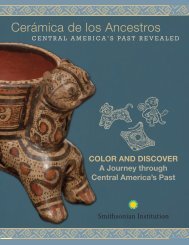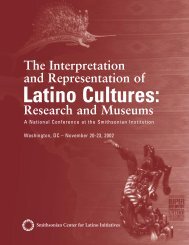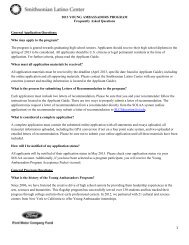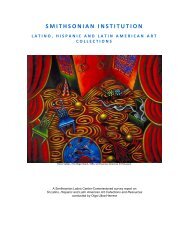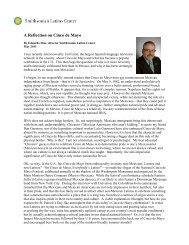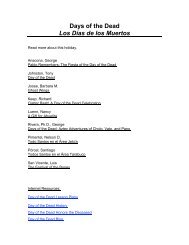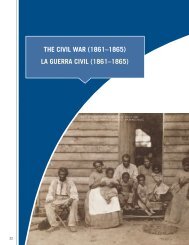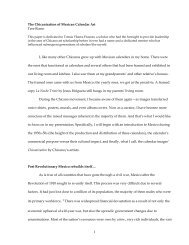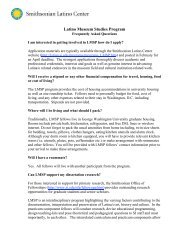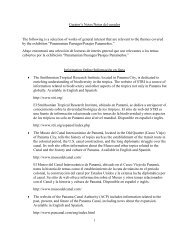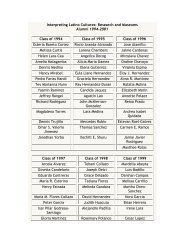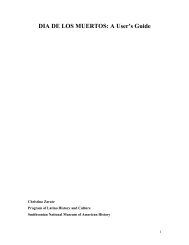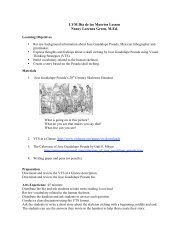Revealing Ancestral Central America - Smithsonian Latino Center ...
Revealing Ancestral Central America - Smithsonian Latino Center ...
Revealing Ancestral Central America - Smithsonian Latino Center ...
Create successful ePaper yourself
Turn your PDF publications into a flip-book with our unique Google optimized e-Paper software.
Fig. 36. Classic period<br />
Maya blades, AD<br />
250–900. San Miguel de<br />
Mercedes, Chalatenango<br />
Department, El Salvador.<br />
Obsidian. Collected or<br />
excavated by Samuel K.<br />
Lothrop, 1926.<br />
Fig. 36<br />
the floor in the innermost (highest) back<br />
room and “read,” then interpreted, for a<br />
person standing outside listening through<br />
a lattice window. Another lattice window is<br />
in the front of the building, where a villager<br />
could approach and discuss with the diviner<br />
what he or she needed. If an agreement was<br />
reached, the client would often leave an artifact<br />
for payment. While many of the artifacts<br />
left could be used by both genders, there<br />
were no predominantly male-use artifacts,<br />
and there were frequent female-use artifacts<br />
such as spindle whorls for making cotton<br />
thread for weaving, and grinding stones for<br />
food processing. Therefore it appears the<br />
diviner was a woman.<br />
Structure 10, adjacent to the diviner’s<br />
building, was also clearly religious, with successively<br />
higher rooms, white-painted walls,<br />
and red decorations, but it functioned in a very<br />
different fashion. It hosted ceremonies for the<br />
village, with a focus on deer as symbolic of<br />
the fertility of nature and a successful harvest.<br />
The front and lowermost room is large and<br />
held more food than any other building in the<br />
site excavated so far. That room also processed<br />
food, with grinding stones and hand<br />
stones called metates and manos, like those<br />
found at other sites in El Salvador. A hearth<br />
here was used for cooking. The foods were<br />
dispensed to participants over a half-height<br />
wall. Outside the building the ground was<br />
kept clear of artifacts, trash, and vegetation,<br />
and was very hard-packed by use.<br />
The Maya have a deep belief in cyclicity,<br />
linking the rising and setting of the sun,<br />
planets, and stars with the cycle of maize.<br />
Maize for planting is stored dormant/dry<br />
during the half-year dry season, and then<br />
springs to life as it is planted and grows during<br />
the rainy season. It is a powerful metaphor<br />
for human reproduction. Mature maize drying<br />
in the field, mature guayaba fruits, and<br />
other seasonal indicators excavated at Joya<br />
de Cerén point toward August as the time of<br />
the volcanic eruption. Today the Maya village<br />
ceremony for fertility and harvest, called cuch,<br />
is celebrated in August.<br />
The two uppermost and innermost rooms<br />
stored special artifacts, including a large pottery<br />
vessel, decorated with a caiman head and<br />
legs and loaded with achiote seeds. These<br />
seeds provided a bright red pigment that<br />
probably symbolized human blood, as it still<br />
does today. A typical obsidian knife (Figure<br />
36) stored on the shelf above the seeds had<br />
human hemoglobin on it, and was surely used<br />
in bloodletting. The Maya still believe that<br />
human blood is the most religiously charged<br />
substance in the body, and when it is shed<br />
in ceremony it is the most effective way to<br />
communicate with the supernatural domain.<br />
Beside the knife was a deer skull headdress<br />
that retained white, red, and blue paint, and<br />
28 REVEALING ANCESTRAL CENTRAL AMERICA



